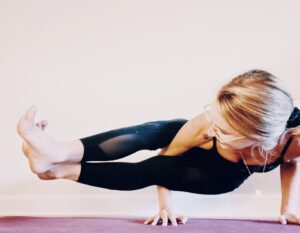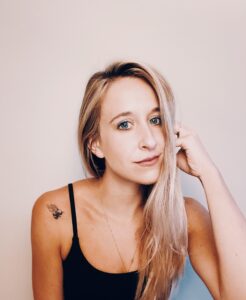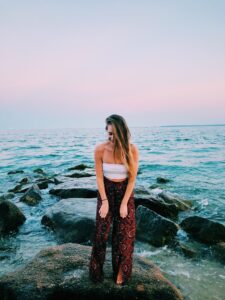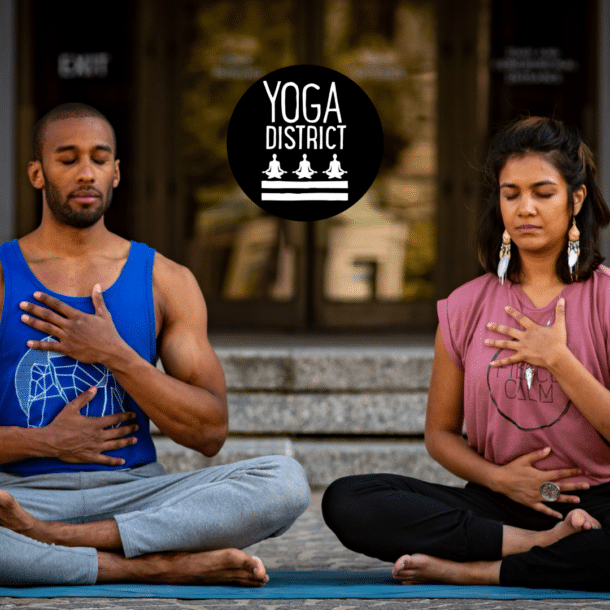 To celebrate Pride Month, we collaborated with a Yoga District member to highlight Lesbian, Gay, Bisexual, Transgender, Queer and/or Questioning, Intersex, and Asexual and/or Ally (LGBTQIA+) voices, leaders, and practitioners in our community.
To celebrate Pride Month, we collaborated with a Yoga District member to highlight Lesbian, Gay, Bisexual, Transgender, Queer and/or Questioning, Intersex, and Asexual and/or Ally (LGBTQIA+) voices, leaders, and practitioners in our community.
Meet Ciara, a member of both the Yoga District and the LGBTQIA+ community. Learn about her journey with yoga and how she feels yoga communities can create a more inclusive space for LGBTQIA+ yogis.
Tell us about yourself?
I’m an ecofeminist, first-generation American, and proud member of the LGBTQIA+ community (1, 2). I’ve lived in many cities around the world throughout my life, but D.C. is the first place that feels like home.
During the day, I work as a human rights lawyer. I’m most passionate about advocating for rights at the intersection of gender and disability (e.g. ensuring women with disabilities can exercise full reproductive autonomy).
In the evening, I like to curl up on the couch with my dog, tea, and a good book. I’m happiest at golden hour near the water.
How would you describe your yoga journey?
 My yoga journey, in one word, is “healing.” I grew up as an elite athlete and was constantly learning how to make my body smaller, faster, and leaner. As a result, I formed a somewhat unhealthy relationship with my body at a young age. When I retired from my sport, this unhealthy relationship continued to grow as I suddenly felt disconnected from my body.
My yoga journey, in one word, is “healing.” I grew up as an elite athlete and was constantly learning how to make my body smaller, faster, and leaner. As a result, I formed a somewhat unhealthy relationship with my body at a young age. When I retired from my sport, this unhealthy relationship continued to grow as I suddenly felt disconnected from my body.
Yoga has allowed me to reconnect with my body in a healthy way. Through my practice, I’m learning to accept the beautiful ways in which my body can move and take up space. I’ve learned that wherever I am in my body, each day is enough.
I love how yoga brings people together and creates a strong sense of community. The practice of yoga creates a safe space for humans of all backgrounds and experiences to move and breathe together.
If I could take a yoga class with anyone?
I would invite the whole “Squad” (Alexandria Ocasio-Cortez, Ilhan Omar, Ayanna Pressley, Rashida Tlaib). Instead of playing music, we could do yoga to the sound of the Ginsburg Confirmation Hearings.
How can yoga’s public image in America become more inclusive? What can teachers, staff, and students do to make yoga classes more inclusive toward the LGBTQIA+ community?
 Much of the marketing around yoga excludes the BIPOC community, people of diverse gender and sexual identities, people with disabilities, people with low incomes, and people who do not meet traditional notions of “beauty” in our society (3). This marketing renders yoga inaccessible to many.
Much of the marketing around yoga excludes the BIPOC community, people of diverse gender and sexual identities, people with disabilities, people with low incomes, and people who do not meet traditional notions of “beauty” in our society (3). This marketing renders yoga inaccessible to many.
The yoga community is diverse, and it is beautiful in its diversity. Our public image should reflect the notion that all people belong in the yoga community. All bodies and identities are welcome here.
Within the yoga community, far too many in our LGBTQIA+ community are trauma survivors. Yoga teachers and studio staff should do everything they can to ensure that all classes are trauma-informed. Teachers, in particular, should identify ways to ask for students’ consent before providing hands-on assists/adjustments (or avoid hands-on assists entirely). For practitioners looking to support LGBTQIA+ yoga communities, check out “Guidelines and Grace: Recommendations for Teaching Trauma-Informed Yoga” to learn more about trauma-informed yoga (4).
 In addition to being trauma-informed, staff and teachers should be gender-inclusive. It’s likely that teachers and staff won’t know every student’s preferred pronouns (5). As a result, they should be intentional about the language they use to avoid gendered terms that may exclude some students. To learn more about how to create a more inclusive space in yoga, “Incorporate LGBTQIA+ Inclusive Language into Your Yoga Class” is a helpful resource (6).
In addition to being trauma-informed, staff and teachers should be gender-inclusive. It’s likely that teachers and staff won’t know every student’s preferred pronouns (5). As a result, they should be intentional about the language they use to avoid gendered terms that may exclude some students. To learn more about how to create a more inclusive space in yoga, “Incorporate LGBTQIA+ Inclusive Language into Your Yoga Class” is a helpful resource (6).
Yoga is about union; the union of breath and body, and the union between persons and the communities to which they belong.
What would you say to your teenage self?
If I could talk to my teenage self, I would tell them that they deserve to feel at home in their body, in every way.
Sources
- What Is Ecofeminism? Understanding The Intersection Of Gender & The Environment, https://www.mindbodygreen.com/articles/ecofeminism-history-and-principles
- Acronyms Explained, https://outrightinternational.org/content/acronyms-explained
- Why We Use BIPOC, https://www.ywcaworks.org/blogs/ywca/fri-01152021-1332/why-we-use-bipoc#:~:text=DEFINITION,Indigenous%2C%20and%20people%20of%20color.
- Guidelines and Grace: Recommendations for Teaching Trauma-Informed Yoga, https://yogamedicine.com/recommendations-for-teaching-trauma-informed-yoga/
- What are Personal Pronouns and Why Do They Matter?, https://www.mypronouns.org/what-and-why
- Incorporate LGBTQIA+ Inclusive Language into Your Yoga Class, https://chopra.com/articles/incorporate-lgbtqia-inclusive-language-into-your-yoga-class

